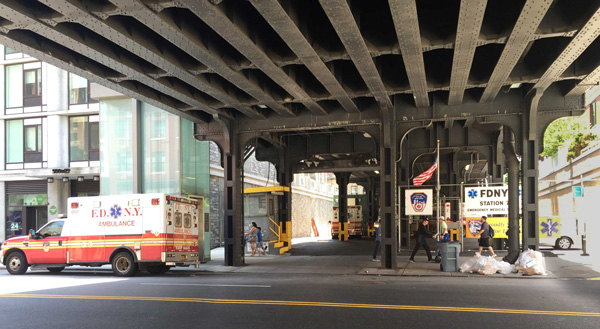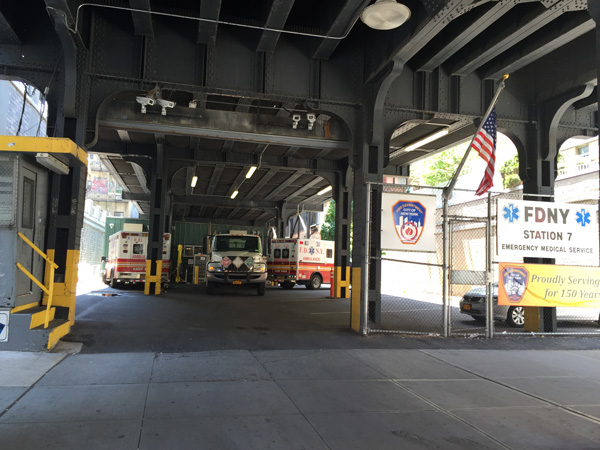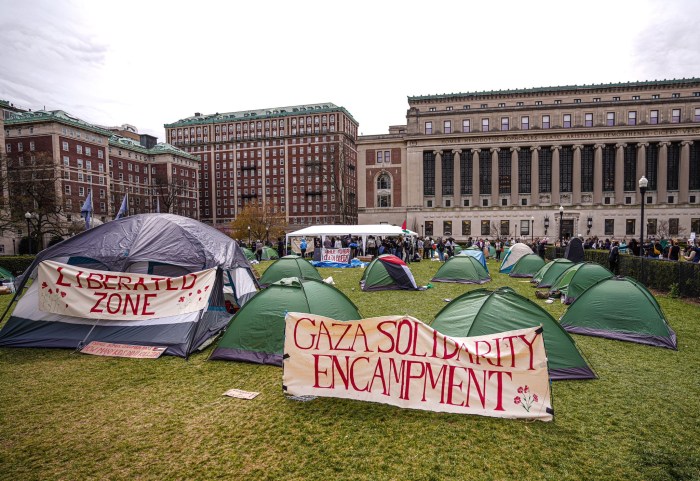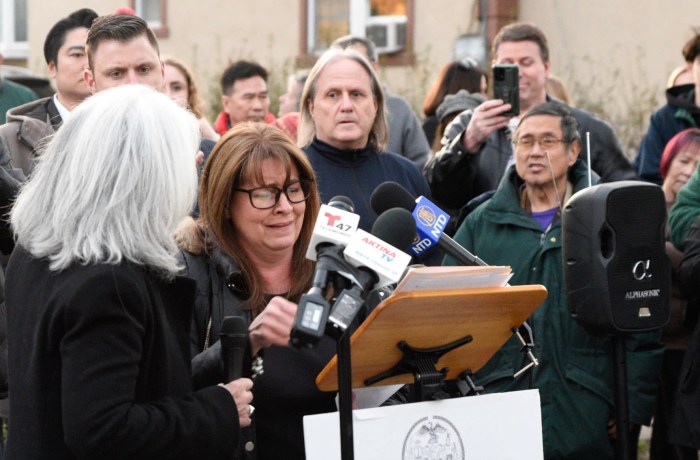BY WINNIE McCROY | When the Fire Department of New York (FDNY) situated Emergency Medical Service 7 under the High Line on West 23rd Street (btw. 9th & 10th Aves.) in November 2011, it was in response to the closing of St. Vincent’s Hospital, and the need for medical services on Manhattan’s West Side.

“Back then, the FDNY and DCAS [Department of Citywide Administrative Services] were scrambling to find a location, and maybe were not fully done discussing the idea with the community,” said Community Board 4 (CB4) chair Christine Berthet. “Everyone could see it was the wrong location because it was adjacent to residences and had no roof, but they did the best they could by themselves and found that location, and it was a simple solution in a crunch.”
Years later, the open-air station still exists on a residential block that neighbors and community leaders believe is ill-suited for the purpose. Now, with the help of Councilmember Corey Johnson, they hope to find a permanent location for the EMS station that has brought loud sirens, overcrowding and continuous emissions from idling vehicles to their environs for far too long.
Johnson first began working to relocate this EMS station while serving as chair of CB4. Initially, he helped pass a resolution denying the FDNY’s application to locate the station in this high-density area, to no avail.
“I felt strongly then, as I do now, that an unenclosed emergency service station under the High Line on a residential block is not a suitable location for an EMS station,” wrote Johnson in a June 19 letter to Commissioner Stacey Cumberbatch of DCAS and Director Dean Fuleihan of the Office of Management & Budget.
“While I appreciate the critical need of an EMS station that can effectively respond to emergencies in our community, this temporary space under the High Line will be unable to meet growing needs as thousands of new residents move to Manhattan’s West Side as part of the Hudson Yards Redevelopment Project,” he added.
Berthet said that from day one, CB4 knew the EMS station would cause problems. But, “unfortunately, that was the quick and dirty solution, and then they were supposed to work on a longer-term plan. Unfortunately, as is the tendency with the city, the quick and dirty becomes permanent. It may not be forever, but it’s a long time — about five years now.”
That’s five years too long for local residents and business owners, who have had enough of the EMS station. Residents deal with sirens, exhaust from idling vehicles and crowded streets.
“It’s very disruptive; my life is intolerable,” said Susan Singer, a resident of London Terrace for 19 years. “I have witnessed vehicles going against traffic at 5 p.m. with the sirens blaring, only to park the vehicle, not to run to an emergency. All residents at London Terrace have been impacted by this.”
Singer, a realtor, said that the station brings down property values and quality of life across Chelsea. When you consider the price points people pay for apartments in the area, said Singer, it’s unfair to ask them to tolerate this.
“They say they don’t turn their sirens on until 10 a.m., but residents in 465 and 470 West 23rd Street can tell you exactly when they start: 8:15 a.m.,” said Singer. “You also have to think about local businesses where people may be dining outdoors. It makes no sense to have this in an affluent, go-to part of the neighborhood.”
Chelsea Now contacted several local businesses including the Half King Restaurant (at 505 W. 23rd St.), but none reported any significant problems due to the EMS station. Still, local leaders cannot ignore the mounting complaints from residents over the emissions and noise.
“This current location prohibits FDNY from making substantial improvements to their facility, like enclosing the station to capture emissions and noise, which are creating dangerous, unhealthy conditions for residents of neighboring buildings,” said Johnson. “For these reasons, it is critically important that EMS Station 7 is relocated to a new, permanent location that can fully support the operational needs of the FDNY as soon as possible.”
This new location, as determined by discussions with CB4, DCAS, the FDNY and real estate developers, will be on W. 29th St. (btw. 11th & 12th Aves). Johnson has urged DCAS to work with the FDNY to evaluate this as a permanent location for EMS 7.
After speaking with the FDNY and the developer, he believes the proposed site on W. 29th St. can provide ample vehicle capacity and space for FDNY to expand their services. In addition, the developer will work with the Department of City Planning, FDNY, and relevant city agencies to design a building that is flood-resilient to coastal flooding.
Berthet said that working with developers will be paramount, noting that the city must put energy into negotiating a lease for this location and making sure that the developer is included in the plans from the get-go, so it happens as it should.
The Quality of Life Committee at CB4 would also like to see the FDNY come back to them to discuss their desire to get the Department of Transportation to dedicate the appropriate amount of parking spaces for emergency workers’ personal vehicles.
“One of the problems emerging is that firemen don’t want to get a ticket from parking in the street, so they park their private car inside the lots and the ambulances are moved out to the street,” said Berthet. “We would prefer to do the reverse — have dedicated curbside parking for them, which is the case at most fire stations. At least that would free up some space inside the station.”
The other request they have is that EMS 7 serves as a pilot program for the adoption of a new electric idling system, so that ambulances could be plugged into an electrical outlet.
“This would allow the ambulances to remain cold inside, because their medical machines can’t heat up,” said Berthet. “That’s the reason that they are always idling. We are exploring the technology to replace that idling with these electric plugs. And we have asked that 23rd Street be made one of the places they test that first, to get the benefits of that technology before the rest of the city, because we need it so badly.”
Berthet would like to see movement on the technology issue by September or October, and on the two short-term items even sooner. Legally, she noted, no vehicles should remain idling for more than three minutes. But these are emergency vehicles serving a higher order of business: to save lives. Although few people are thrilled about the current location of the EMS 7, all agree that the West Side needs this resource to keep its residents safe.
“One of my highest priorities is that our community receives and has access to quality and comprehensive health care,” concluded Johnson. “This includes ensuring that first responders can effectively respond to emergencies on Manhattan’s West Side. The FDNY cannot, however, simple settle into their current location on West 23rd Street.”


















